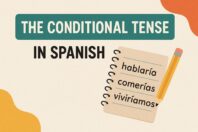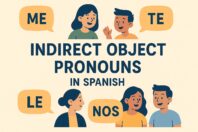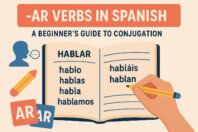Present Progressive in Spanish: A Guide to the “-ing” Conjugation

Get our free email course, Shortcut to Conversational.
Have conversations faster, understand people when they speak fast, and other tested tips to learn faster.
More infoWhat are you doing? What was she thinking? Why are they dancing? Indeed, you use the “-ing” form of verbs a lot in English.
And it’s no different in Spanish. Aside from the infinitive form and present tense, the most-used verb form is the present progressive, using the Spanish version of the “-ing” form called the gerund.
Luckily, it’s just as easy as in English. In this guide, we’ll show you how to do it. We’ll start with how to conjugate the gerund form, we’ll move on to how to use the gerund with the verb estar, and we’ll end with the contexts where we use the present progressive tense in Spanish. Unlike English, the progressive in Spanish is only used to talk about actions in process, not as a future tense or for ongoing actions!
Now let’s get started…
-ing in Spanish: Conjugation of the gerund
In Spanish, to convert a verb from the infinitive to the gerund form, we use one of two different endings. These are applied both to regular verbs and irregular verbs, based simply on the endings of their infinitive forms.
-ar verbs: -ando
To get the gerund of -ar verbs, we just chop off the -ar and replace it with -ando. Here are a few examples:
| Spanish infinitive | Spanish gerund | English infinitive | English gerund |
| caminar | caminando | to walk | walking |
| cocinar | cocinando | to cook | cooking |
| besar | besando | to kiss | kissing |
-er and -ir verbs: -iendo
For the other two Spanish verb forms, we just chop off the -er or -ir endings and replace them with -iendo to get the gerund. Let’s see a few examples:
| Spanish infinitive | Spanish gerund | English infinitive | English gerund |
| comer | comiendo | to eat | eating |
| volver | volviendo | to come back | coming back |
| escribir | escribiendo | to write | writing |
| recibir | recibiendo | to receive | receiving |
Irregular verbs
The good news with forming the gerunds from irregular verbs is that the endings are still the same as we saw above. When learning the specifics of each irregular verb, you’ll just need to learn how the stem changes. Here are some of the most common ones:
| Spanish infinitive | Spanish gerund | English infinitive | English gerund |
| venir | viniendo | to come | coming |
| decir | diciendo | to tell | telling |
| sentir | sintiendo | to feel | feeling |
| pedir | pidiendo | to ask | asking |
| dormir | durmiendo | to sleep | sleeping |
i to y change: -yendo verbs
The other irregular gerund form you need to know is with -yendo verbs: in cases where the -iendo would be attached to a vowel, we replace the i with a y. Let’s see this with some examples (notice that the gerunds here are not iendo, leiendo, creiendo, and trayendo!):
| Spanish infinitive | Spanish gerund | English infinitive | English gerund |
| ir | yendo | to go | going |
| leer | leyendo | to read | reading |
| creer | creyendo | to believe | believing |
| traer | trayendo | to bring | bringing |
Pronunciation tip: Remember, this “y” sounds like an English “j” in most Latin American countries.
How to use the present progressive in Spanish
Now that you know how to form the Spanish gerund form, it’s time to learn how to use it in a sentence. Just like in English, you wouldn’t usually just say “walking,” you’d rather say “I’m walking.” In Spanish it’s the same, where the “I’m” part is “yo estoy.” We use the verb estar as the auxiliary verb with the gerund to create the present progressive form.
To sum up, the Spanish sentence structure in present progressive is:
subject + [estar, conjugated in present tense] + [gerund]
Let’s review the present tense estar conjugation:
| Subject | Estar present tense | To be in English |
| Yo | estoy | I am |
| Tú | estás | You are |
| Él, Ella, Usted | está | He is, She is, You are |
| Nosotros, Nosotras | estamos | We are |
| Ustedes | están | You [all] are |
| Ellos, Ellas | están | They are |
Now that you know how to get the gerund form, and you’ve reviewed the conjugations of our auxiliary verb estar, you have everything you need to start using the Spanish present progressive tense! Let’s see this in action with a few types of simple sentences:
Present progressive in the affirmative:
- Valentina está escuchando música. – Valentina is listening to music.
- Sophia está estudiando. – Sophia is studying.
- Yo estoy viajando. – I’m traveling.
Present progressive in the negative:
- El cajero automático no está funcionando. – The cash machine isn’t working.
- Alejandro no está caminando. – Alejandro isn’t walking.
- Nosotros no estamos durmiendo. – We’re not sleeping.
Present progressive in questions:
- ¿Adrián está corriendo? – Is Adrian running?
- ¿Qué estás haciendo, Ignacio? – What are you doing, Ignacio?
- ¿Están entendiendo? – Are they understanding?
When to use present progressive Spanish
So far so good, right? We’re almost done!
In the first two sections we learned the progressive tense conjugation: we get the gerund form from the verb stem, and then we use the conjugated form of estar with the gerund to complete the progressive form. The result is the equivalent of the English “-ing” form.
But can we use the Spanish progressive the same way as in English? Not quite.
In this section we’ll introduce the contexts where we use the Spanish progressive. While the most common ones are the same as in English, it’s vital to be clear on which contexts we can and can’t use the present progressive in Spanish. Let’s see each one here.
Actions happening right now
As in English, we use the Spanish present progressive to say what’s happening at the moment of speaking. This is by far the most common use of the present progressive in Spanish!
- ¿Puedo llamar de vuelta? Estoy conduciendo. – Can I call you back? I’m driving.
- ¡Chito! El bebé está durmiendo. – Shush! The baby is sleeping.
Note that to use the present progressive in Spanish, these actions must actually be in process when we mention them! Otherwise we use present indicative Spanish, even where in English you can often still use the -ing form:
- Present indicative: Mi hermano duerme en nuestro sofá cada vez que pasa la noche. – My brother is sleeping on the couch whenever he spends the night.
During an ongoing situation
In some contexts we can use the present progressive even when the specific action isn’t happening at the exact moment of speech, as long as we’re describing a situation that’s ongoing for the moment.
- Estoy leyendo la serie de Harry Potter. – I’m reading the Harry Potter series.
- Estamos construyendo una casa de vacaciones en las montañas. – We’re building a vacation house in the mountains.
Repetitive actions, for emphasis
For most habitual actions, in Spanish we generally use the present indicative tense. In cases where we really want to emphasize the repetition, however, we can use the present progressive.
- No quiero mudarme a Seattle. ¡Siempre está lloviendo allí! – I don’t want to move to Seattle. It is always raining there!
- ¡Mi mamá siempre me está diciendo cómo vivir mi vida! – My mom is always telling me how to live my life!
Note the difference in emphasis between these first two examples, and the next ones where we’re just stating the facts:
- Present indicative: Siempre llueve en Seattle. – It always rains in Seattle.
- Present indicative: Mi mamá siempre me dice cómo vivir mi vida. – My mom is always telling me how to live my life.
Not for the future!
In English, you often use the -ing form to talk about what you’re going to do. In Spanish, however, we cannot use the present progressive form. Instead, we need to use a future verb tense.
Be careful when you translate such phrases from English, as it’s a very common beginner mistake!
- Spanish future tense using “voy a”: Voy a comer un burrito cuando lleguemos al restaurante. – I’m eating a burrito when we get to the restaurant.
- Future simple Spanish: Compraremos un auto nuevo una vez que vendamos el viejo. – We’re buying a new car once we sell the old one.
Conclusion: Present progressive Spanish
Today we covered one of the most common verb forms in the Spanish language: the present progressive tense.
We started by learning how to take the verb stem from Spanish infinitives to get the gerund, which is the equivalent of the English “-ing” form. The ending is -ando for -ar verbs and -iendo for -er and -ir verbs, with the only exception being -yendo for verbs whose stems end in vowels. We nonetheless saw that some irregular verbs are still stem-changing in their gerund form.
To use the gerund, we always use estar as the auxiliary verb. We reviewed the present indicative estar conjugation, and then saw plenty of example sentences using this progressive verb tense.
Finally, we went over when to use the present progressive in Spanish. For the most part, it’s used to describe actions that are happening at the moment of speech, though it can also be used for ongoing actions. In contrast to English, the Spanish present progressive cannot be used to talk about the future.
With that, we hope you’re ready to use this common Spanish verb form as you interact with Spanish speakers. What do you think? Estás leyendo este artículo y estás aprendiendo el presente progresivo. – You’re reading this article, and you’re learning the present progressive!
TIP: Try our Private Memrise flashcards for free, where you can train every lesson, including this one. They’re the same flashcards our students use!


